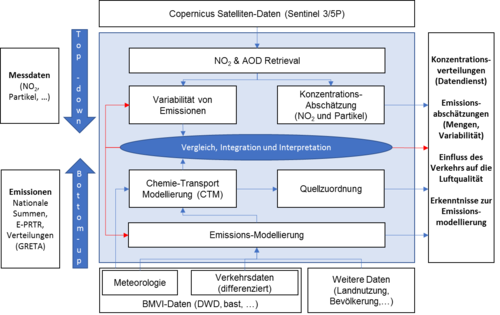Sentinel-based atmospheric products for assessing the impact of traffic emissions on air quality in Germany (S-VELD).
Air quality plays an important role in the current environmental discussion. In fact, millions of people worldwide now live in regions with heavily polluted air. Exceedances of the limit values for nitrogen dioxide and particulate matter are mainly found at locations close to traffic. In the S-VELD (mFUND) project funded by the BMVI, these traffic-related pollutant emissions and their share of environmental pollution in Germany are being studied in more detail on the basis of the latest Sentinel satellite data.
Ground-level NO2 and particulate matter concentrations for Germany and its neighboring countries are derived from observations of Sentinel-3 and -5P satellite data and made available to end users via a web mapping data service. Likewise, statements on the emission situation are derived from the sentinel data.
The collected remote sensing data are subsequently combined with emission models as well as dispersion models. Based on spatially and temporally detailed traffic load data, high-resolution emission data of motor vehicle traffic are determined using technology-dependent emission factors.
By combining the different methodological approaches, a better understanding of traffic emissions and their contribution to air pollution is achieved. The results are of great importance for air quality assessment and provide an important basis for further policy planning in the development of proportionate and effective air pollution control measures.
The Tropospheric Environmental Research Group of the Institute of Meteorology is also part of the S-VELD (mFUND) consortium and contributes significantly to the optimization of particulate matter concentration distributions and the identification of regions with dominant transport contributions. For more information, please visit the S-VELD project website.
